Applied Physics
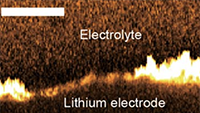
Lithium metal batteries are attractive for next-generation energy storage because of their high energy density. A major obstacle to their commercialization is the uncontrollable growth of lithium dendrites, which arises from complicated but poorly understood interactions at the electrolyte/electrode interface. In this work, we use a machine learning-based artificial neural network (ANN) model to explore how the lithium growth rate is affected by local material properties, such as surface curvature, ion concentration in the electrolyte, and the lithium growth rates at previous moments. The ion concentration in the electrolyte was acquired by Stimulated Raman Scattering Microscopy, which is often missing in past experimental data-based modeling. The ANN network reached a high correlation coefficient of 0.8 between predicted and experimental values. Further sensitivity analysis based on the ANN model demonstrated that the salt concentration and concentration gradient, as well as the prior lithium growth rate, have the highest impacts on the lithium dendrite growth rate at the next moment. This work shows the potential capability of the ANN model to forecast lithium growth rate, and unveil the inner dependency of the lithium dendrite growth rate on various factors.
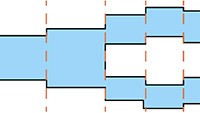
We present an inverse design method for achieving unprecedented performance
and ultra wide bandwidth based on direct adaptive refinement of the device geometry. We
experimentally demonstrate a 90/10 splitter with more than 200 nm bandwidth.
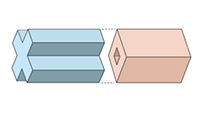
Ziwei Zhu and Changxi Zheng
Differentiable scattering matrix for optimization of photonic structures.
Optics Express, 28 (25), 2020
Paper (PDF) Abstract Source Code
Differentiable scattering matrix for optimization of photonic structures.
Optics Express, 28 (25), 2020
Paper (PDF) Abstract Source Code
The scattering matrix, which quantifies the optical reflection and transmission of a photonic structure, is pivotal for understanding the performance of the structure. In many photonic design tasks, it is also desired to know how the structure's optical performance changes with respect to design parameters, that is, the scattering matrix's derivatives (or gradient). Here we address this need. We present a new algorithm for computing scattering matrix derivatives accurately and robustly. In particular, we focus on the computation in semi-analytical methods (such as rigorous coupled-wave analysis). To compute the scattering matrix of a structure, these methods must solve an eigen-decomposition problem. However, when it comes to computing scattering matrix derivatives, differentiating the eigen-decomposition poses significant numerical difficulties. We show that the differentiation of the eigen-decomposition problem can be completely sidestepped, and thereby propose a robust algorithm. To demonstrate its efficacy, we use our algorithm to optimize metasurface structures and reach various optical design goals.

Ziwei Zhu, Utsav D. Dave, Michal Lipson, and Changxi Zheng
Inverse Geometric Design of Fabrication-Robust Nanophotonic Waveguides.
Conference on Lasers and Electro-Optics (CLEO), May 2020
(Oral presentation)
Paper (PDF) Abstract
Inverse Geometric Design of Fabrication-Robust Nanophotonic Waveguides.
Conference on Lasers and Electro-Optics (CLEO), May 2020
(Oral presentation)
Paper (PDF) Abstract
We present an inverse design method making waveguides with high performance and high robustness to fabrication errors. As an example, we show a 1-to-4 mode converter > -1.5 dB conversion efficiency under geometric variations within fabrication tolerances.
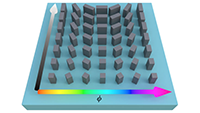
Metasurfaces are optically thin metamaterials that promise complete control of the wavefront of light but are primarily
used to control only the phase of light. Here, we present an approach, simple in concept and in practice, that uses
meta-atoms with a varying degree of form birefringence and rotation angles to create high-efficiency dielectric
metasurfaces that control both the optical amplitude and phase at one or two frequencies. This opens up applications
in computer-generated holography, allowing faithful reproduction of both the phase and amplitude of a target
holographic scene without the iterative algorithms required in phase-only holography. We demonstrate all-dielectric
metasurface holograms with independent and complete control of the amplitude and phase at up to two optical
frequencies simultaneously to generate two- and three-dimensional holographic objects. We show that phaseamplitude metasurfaces enable a few features not attainable in phase-only holography; these include creating artifact-free two-dimensional holographic images, encoding phase and amplitude profiles separately at the object plane,
encoding intensity profiles at the metasurface and object planes separately, and controlling the surface textures of
three-dimensional holographic objects.

We study the application of laser-heating technology to browning dough, due to its potential for high-resolution spatial and surface color control. An important component of this process is the identification of how laser parameters affect browning and baking and whether desirable results can be achieved. In this study, we analyze the performance of a carbon dioxide (CO2) mid-infrared laser (operating at 10.6 micrometer wavelength) during the browning of dough. Dough samples--consisting of flour and water--were exposed to the infrared laser at different laser power, beam diameter, and sample exposure time. At a laser energy flux of 0.32 MW m^{-2} (beam diameter of 5.7 mm) and sample exposure time of 180 s we observe a maximum thermal penetration of 0.77 mm and satisfactory dough browning. These results suggest that a CO2 laser is ideal for browning thin goods as well as for food layered manufacture.
@article{blutinger2019characterization,
title={Characterization of CO2 laser browning of dough},
author={Blutinger, Jonathan David and Meijers, Yor{\'a}n and Chen, Peter Yichen and
Zheng, Changxi and Grinspun, Eitan and Lipson, Hod},
journal={Innovative Food Science and Emerging Technologies},
volume={52},
pages={145--157},
year={2019},
publisher={Elsevier}
}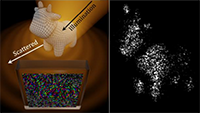
We report a high-efficiency dielectric metasurface with continuous and arbitrary control of both amplitude and phase of one or two colors simultaneously. We numerically and experimentally demonstrate 2D and 3D holograms using such metasurfaces.
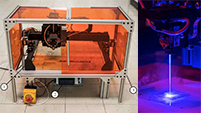
Depth of heat penetration and temperature must be precisely controlled to optimize nutritional value, appearance, and taste of food products. These objectives can be achieved with the use of a high-resolution blue diode laser---which operates at 445nm---by adjusting the water content of the dough and the exposure pattern of the laser. Using our laser, we successfully cooked a 1mm thick dough sample with a 5mm diameter ring-shaped cooking pattern, 120 repetitions, 4000mm/min speed, and 2W laser power. Heat penetration in dough products with a blue laser is significantly higher compared to with an infrared laser. The use of a blue laser coupled with an infrared laser yields most optimal cooking conditions for food layered manufacture.
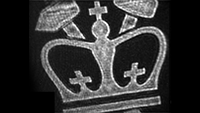
We report a high-efficiency dielectric metasurface with continuous and arbitrary control of both amplitude and phase. We experimentally demonstrated the advantages of complete wavefront control by comparing amplitude-phase modulation metasurface holograms to phase-only metasurface holograms.
Loading ......
COPYRIGHT 2012-2018. ALL RIGHTS RESERVED.
